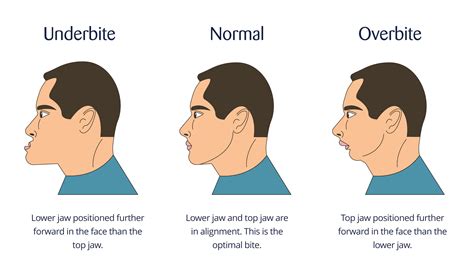How Are Underbites Fixed

An underbite, a condition where the lower teeth overlap the upper teeth, is a common dental issue that can cause discomfort, affect chewing and speaking, and impact self-confidence. Fixing an underbite requires a comprehensive approach that involves orthodontic treatment, surgical intervention, or a combination of both. The goal of treatment is to realign the teeth and jaw, restoring a harmonious bite and improving overall oral function.
Understanding Underbites
Before diving into the treatment options, it’s essential to understand the causes of underbites. Underbites can be caused by a combination of genetic and environmental factors, including:
- Genetics: Family history can play a significant role in the development of underbites.
- Jaw growth: Abnormal growth patterns of the upper or lower jaw can contribute to underbites.
- Tooth alignment: Crooked or overcrowded teeth can exacerbate underbites.
- Habits: Prolonged habits like thumb-sucking or tongue-thrusting can influence jaw growth and tooth alignment.
Orthodontic Treatment
Orthodontic treatment is often the first line of defense in fixing underbites. The primary goal is to realign the teeth and improve the bite. Depending on the severity of the underbite, orthodontic treatment may involve:
- Braces: Traditional metal braces or clear aligners can be used to move the teeth into their correct positions.
- Retainers: After orthodontic treatment, retainers are used to maintain the new tooth alignment and prevent relapse.
- Palatal expanders: These devices are used to widen the upper jaw, creating space for the teeth to move into their correct positions.
Surgical Intervention
In more severe cases, surgical intervention may be necessary to correct the underbite. The type of surgery depends on the underlying cause of the underbite:
- Mandibular advancement: This surgical procedure involves moving the lower jaw forward to improve the bite.
- Maxillary advancement: This procedure involves moving the upper jaw forward to correct the underbite.
- Genioplasty: This surgical procedure involves repositioning the chin to improve the bite and facial aesthetics.
Combination Therapy
In some cases, a combination of orthodontic treatment and surgical intervention may be necessary to fix an underbite. This approach involves:
- Orthodontic preparation: The teeth are aligned and prepared for surgery using orthodontic appliances.
- Surgical correction: The jaw is surgically repositioned to correct the underbite.
- Post-surgical orthodontics: After surgery, orthodontic treatment is used to fine-tune the tooth alignment and ensure a stable bite.
Treatment Considerations
When considering treatment for an underbite, it’s essential to keep the following factors in mind:
- Age: Treatment options may vary depending on the patient’s age. Children and adolescents may require more frequent monitoring and adjustments, while adults may require more invasive treatments.
- Severity: The severity of the underbite will influence the treatment approach. Mild underbites may be corrected with orthodontic treatment alone, while more severe cases may require surgical intervention.
- Overall health: The patient’s overall health and medical history should be taken into account when developing a treatment plan.
What are the benefits of fixing an underbite?
+Fixing an underbite can improve chewing and speaking, reduce jaw pain and discomfort, and enhance self-confidence. Additionally, correcting an underbite can also improve overall oral health and reduce the risk of dental problems like tooth wear and gum disease.
How long does underbite treatment take?
+The duration of underbite treatment varies depending on the severity of the condition and the treatment approach. Orthodontic treatment can take anywhere from 12 to 36 months, while surgical intervention may require a longer recovery period.
Will I need to wear braces after surgery?
+In some cases, yes, you may need to wear braces after surgery to fine-tune the tooth alignment and ensure a stable bite. Your orthodontist or oral surgeon will determine the best course of treatment based on your individual needs.
In conclusion, fixing an underbite requires a tailored approach that addresses the underlying cause of the condition. By understanding the causes of underbites and exploring the various treatment options, individuals can make informed decisions about their care and achieve a healthier, more confident smile.
